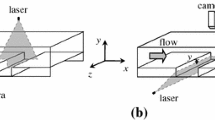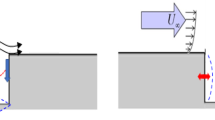Abstract
This experimental study reports flow developments inside a parallelepipedic cavity of variable shape and dimensions. That flow is generated by the interaction between a laminar boundary layer and the cavity, which creates shear-layer oscillations. The aim is to understand the three-dimensional flow morphology varying the Reynolds number and the cavity shape. Flow visualizations are obtained in a plane situated inside the cavity in order to get the dynamical structures. Dimensional analysis of the cavity flow teaches that three dimensionless numbers are necessary for the flow reduction. This is confirmed by experimental results pointing thresholds of appearance of instabilities identified for some combinations of Reynolds number and geometric parameters. The key mechanisms for their existence are centrifugal effects induced by a vortex of spanwise axis with sufficient intensity, and viscous effects due to the wall confinement of the cavity. Their destruction is linked to flow transition to turbulence above a limiting convective velocity generated by the vortex of spanwise axis. These instabilities are generally present in a spanwise row of counter-rotating pairs of vortices, but for some cases, isolated pairs are also identified. Secondary modulations of primary instabilities are also present for particular parameters. Results permit to discriminate the relevant scales associated with the shear layer and the inner cavity flow.






















Similar content being viewed by others
Abbreviations
- A :
-
Plate length upstream of the cavity
- B :
-
Plate length downstream of the cavity
- D :
-
Wind tunnel height
- F :
-
Span ratio
- H :
-
Cavity height
- \( \user1{\mathcal{H}} \) :
-
Helicity
- L :
-
Cavity length
- N :
-
Number of pairs of spanwise vortices
- R :
-
Aspect ratio
- Re :
-
Reynolds number
- S :
-
Cavity span
- t :
-
Time
- U e :
-
External velocity
- U c :
-
Maximum advection velocity inside the cavity
- \( \vec{V} \) :
-
Velocity vector
- W s :
-
Spanwise drift velocity
- (x, y, z):
-
Cartesian coordinates
- δ 2 :
-
Momentum thickness of the upstream boundary layer
- λ :
-
Spanwise wavelength of the instabilities
- μ :
-
Dynamics viscosity
- ν :
-
Kinematics viscosity
- ρ :
-
Density
- \( \overset{\lower0.5em\hbox{$\smash{\scriptscriptstyle\rightharpoonup}$}} {\omega } \) :
-
Vorticity
References
Aymer de la Chevalerie D, Fonteneau A, De Luca L, Cardone G (1997) Görtler-type vortices in hypersonic flows: the ramp problem. Exp Thermal Fluid Sci 15:69–81
Brès GA, Colonius T (2008) Three-dimensional instabilities in compressible flow over open cavities. J Fluid Mech 599:309–339
Chang K, Constantinescu G, Park SO (2006) Analysis of the flow and mass transfer processes for the incompressible flow past an open cavity with a laminar and a fully turbulent incoming boundary layer. J Fluid Mech 561:113–145
Chatellier L, Laumonier J, Gervais Y (2004) Theoretical and experimental investigations of low Mach number turbulent cavity flows. Exp Fluids 36:728–740
Chiang TP, Hwang RR, Sheu WH (1997) On end-wall corner vortices in a lid-driven cavity. J Fluids Eng 119:201–204
Chiang TP, Sheu WH, Hwang RR (1998) Effects of the Reynolds number on the eddy structure in a lid-driven cavity. Int J Numer Methods Fluids 26:557–579
Cui X (2004) Numerical simulations of the generation of Taylor-Görtler vortices during spin-down to rest in finite-length cylinders. Comput Fluids 33:603–621
Faure TM, Adrianos P, Lusseyran F, Pastur L (2007) Visualizations of the flow inside an open cavity at medium range Reynolds numbers. Exp Fluids 42:169–184
Faure TM, Defrasne A, Lusseyran F, Pastur LR (2008) Flow instabilities development inside an open cavity. 13th international symposium on flow visualization, Nice (France), 1–4 July 2008, paper ID 81
Finnis MV, Brown A (1997) The linear growth of Görtler vortices. Int J Heat Fluid Flow 18:389–399
Forestier N, Jacquin L, Geffroy P (2003) The mixing layer over a deep cavity at high-subsonic speed. J Fluid Mech 475:101–145
Freitas CJ, Street RL (1988) Non-linear transport phenomena in a complex recirculating flow: a numerical investigation. Int J Numer Methods Fluids 8:769–802
Gadoin E, Le Quéré P, Daube O (2001) A general methodology for investigating flow instability in complex geometries: application to natural convection in enclosures. Int J Numer Methods Fluids 37:175–208
Ghia U, Ghia KN, Shin CT (1982) High-Re solutions for incompressible flow using the Navier-Stokes equations and a multigrid method. J Comput Phys 48:387–411
Guermond JL, Migeon C, Pineau G, Quartapelle L (2002) Start-up flows in a three-dimensional rectangular driven cavity of aspect ratio 1:1:2 at Re = 1000. J Fluid Mech 450:169–199
Hirsch C (1987) Numerical computation of internal and external flows. Wiley, New York
Koseff JR, Street RL (1984a) Visualization studies of a shear driven three-dimensional recirculating flow. J Fluids Eng 106:21–29
Koseff JR, Street RL (1984b) On end wall effects in a lid-driven cavity flow. J Fluids Eng 106:385–389
Koseff JR, Street RL (1984c) The lid-driven cavity flow: a synthesis of qualitative and quantitative observations. J Fluids Eng 106:390–398
Leonard BP (1979) A stable and accurate convective modeling procedure based on quadratic upstream interpolation. Comput Methods Appl Mech Eng 19:59–98
Migeon C (2002) Details on the start-up development of the Taylor-Görtler-like vortices inside a square-section lid-driven cavity for 1,000 ≤ Re ≤ 3,200. Exp Fluids 33:594–602
Migeon C, Pineau G, Texier A (2003) Three-dimensionality development inside standard parallelepipedic lid-driven cavities at Re = 1000. J Fluids Struct 17:717–738
Navarro-Martinez S, Tutty OR (2005) Numerical simulation of Görtler vortices in hypersonic compression ramps. Comput Fluids 34:225–247
Pereira JCF, Sousa JMM (1995) Experimental and numerical investigation of flow oscillations in a rectangular cavity. J Fluids Eng 117:68–74
Saric WS (1994) Görtler vortices. Annu Rev Fluid Mech 26:379–409
Author information
Authors and Affiliations
Corresponding author
Rights and permissions
About this article
Cite this article
Faure, T.M., Pastur, L., Lusseyran, F. et al. Three-dimensional centrifugal instabilities development inside a parallelepipedic open cavity of various shape. Exp Fluids 47, 395–410 (2009). https://doi.org/10.1007/s00348-009-0671-0
Received:
Revised:
Accepted:
Published:
Issue Date:
DOI: https://doi.org/10.1007/s00348-009-0671-0




